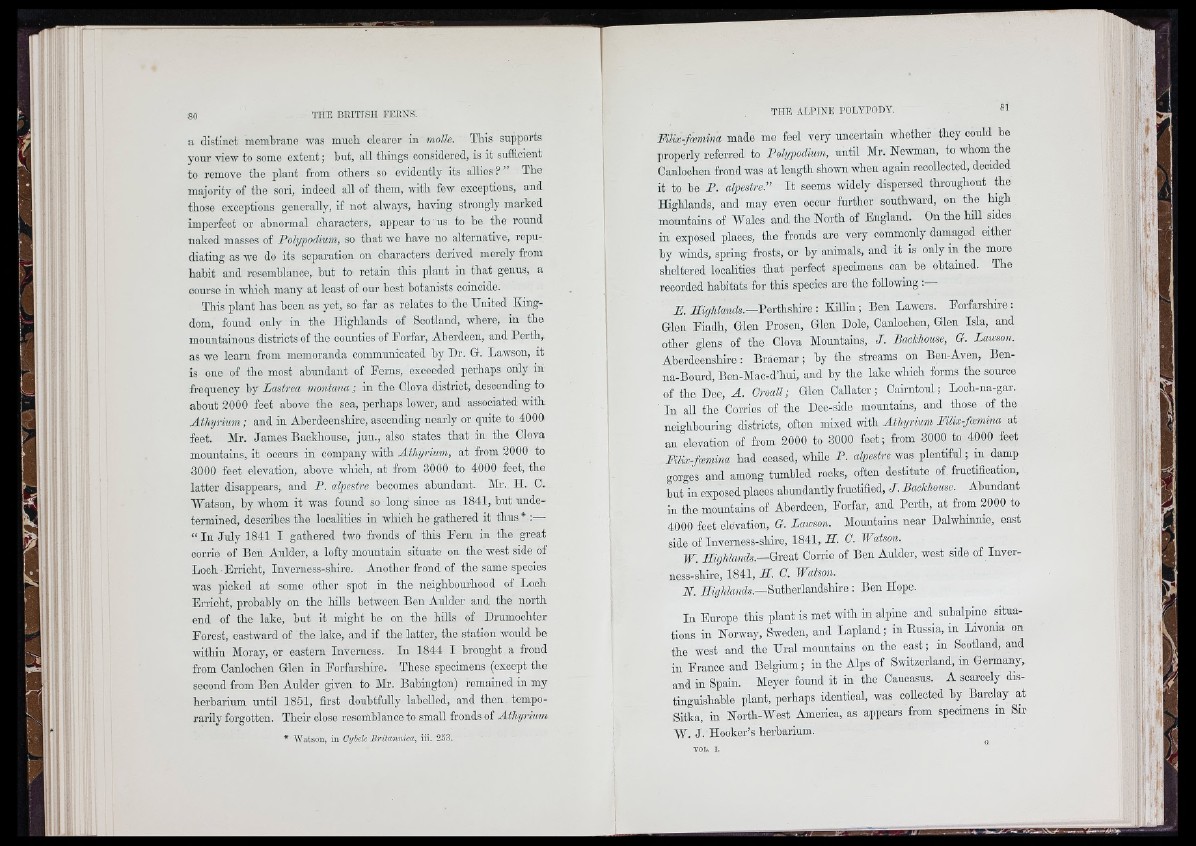
a distinct membrane was muoli clearer in mode. This supports
j'our view to some ex ten t; but, all tilings considered, is it sufficient
to remove tbe plant from others so evidently its allies ? ” The
majority of the sori, indeed all of them, with few oxocptions, and
those exceptions generally, if not always, having strongly marked
imperfect or abnormal characters, appear to us to be tho round
naked masses of Pohjpodium, so that wo have no alternative, repudiating
as Ave do its separation on characters derived merely from
habit and rosemblanco, hut to retain this plant in that genus, a
course in which many at least of our best botanists coincide.
This plant has been as yet, so far as relates to tho United Kingdom,
found only in the Highlands of Scotland, whore, in tho
mountainous districts of the counties of Forfar, Ahordcon, and Perth,
as wc learn from memoranda communicated hy Dr. G. Lawson, it
is one of the most abundant of Ferns, exceeded perhaps only in
frequency by Lastrea montana; in the Clova district, descending to
about 2 0 0 0 feet above tbe sea, perhaps lower, and associated with
Ath y rium ; and in Aberdeenshire, ascending nearly or quite to 4000
feet. Mr. James Backhouse, jun., also states that in the Clova
mountains, it occurs in company with Athyrium, at from 2000 to
3000 feet elevation, above which, at from 3000 to 4000 feet, the
latter disappears, and P. alpestre becomes abundant. Mr. II. C.
Watson, by whom it was found so long since as 1841, but undetermined,
describes the localities in which he gathered it thus * :—
“ In July 1841 I gathered two fronds of this Fern in the great
oorrie of Ben Aulder, a lofty mountain situate on the west side of
Loch Erricht, Inverness-shire. Another frond of the samo species
was picked at some other spot in the neighbourhood of Loch
Erricht, probably on the hills between Bon Anldcr and the north
end of the lake, hut it might ho on the hills of Drumoohter
Forest, eastward of the lake, and if the latter, the station would he
within Moray, or eastern Inverness. In 1844 I brought a frond
from Canloohen Glen in Forfarshire. Thoso specimens (except the
second from Ben Aulder given to Mr. Babington) remained in my
herbarium until 1851, first doubtfully labelled, and then temporarily
forgotten. Their close resemblance to small fronds of Athyrium
* W a tso n , in Cyhdc Britannica, iii. 253.
Filix-fcemina made me feel very uncertain whether they could be
properly referred to Polypodium, until Mr. Newman, to whom the
Canloohen frond was at length shown when again recoUoctod, decided
it to he P. alpestre." I t seems widely dispersed throughout the
Highlands, and may even occur further southward, on tho high
mountains of Wales and the North of England. On the hill sides
in exposed places, the fronds aro very commonly damaged either
hy winds, spring frosts, or hy animals, and it is only in tho more
sheltered localities th a t perfect specimens can he obtainod. Tho
recorded habitats for this species are the following
E. JAi7/itonr&.—Perthshire : K illin ; Bon Lawors. Forfarshire :
Glen Fiadh, Glen Proson, Glen Dole, Canloohen, Glen Isla, and
other glens of the Clova Mountains, J . Backhouse, G. Lawson.
Aberdoenshire: Braemar; by the streams on Bon-Aven, Ben-
na-Bourd, Ben-Mac-d’hui, and hy the lake Avhich forms tho source
of tho Doc, A . Croall; Glen Callator ; Cairntoul; Looh-na-gar.
In all the Corrios of the Dec-side mountains, and those of the
neighbouring districts, often mixed with Athyrium Filix-faemina at
an elevation of from 2000 to 3000 foot; from 3000 to 4000 feet
Filix-fcemina had ceased, while P . alpestre was plentiful; m damp
gorges and among tumbled rocks, often destitute o f, fruotifioation,
hut in exposed places abundantly fructified, J . Backhouse. Abundant
iu tho mountains of Ahordcen. Forfar, and Perth, at from 2000 to
4000 feet elevation, G. Lawson. Mountains near Dalwhinnio, east
side of Invernoss-shiro, 1841, II . C. Watson.
W. Ilicjhlands.— Gr&A. Corrio of Ben Aulder, west side of Inverness
shire, 1841, II . 0. Watson.
JSf. JAi/WanA.—Sutherlandshire : Ben Hope.
In Europe this plant is met with in alpine and subalpine situations
in Norway, Sweden, and Lapland; in Russia, in Livonia on
tho west and the Ural mountains on the oast; m Scotland, and
in France and Belgium; in tho Alps of Switzerland, in Germany,
and in Spain. Meyer found it in the Caucasus. A scarcely distinguishable
plant, perhaps identical, was collected by Barclay at
Sitka, in North-West America, as appears from specimens in Sir
W . J. Hooker’s herbarium.
i i
' i l ■ ' i l
H'l
^ M